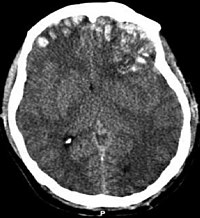
Photo from wikipedia
Background Although thalamic magnetic resonance (MR) spectroscopy (MRS) accurately predicts adverse outcomes after neonatal encephalopathy, its utility in infants without MR visible deep brain nuclei injury is not known. We… Click to show full abstract
Background Although thalamic magnetic resonance (MR) spectroscopy (MRS) accurately predicts adverse outcomes after neonatal encephalopathy, its utility in infants without MR visible deep brain nuclei injury is not known. We examined thalamic MRS metabolite perturbations in encephalopathic infants with white matter (WM) injury with or without cortical injury and its associations with adverse outcomes. Methods We performed a subgroup analysis of all infants recruited to the MARBLE study with isolated WM or mixed WM/cortical injury, but no visible injury to the basal ganglia/thalamus (BGT) or posterior limb of the internal capsule (PLIC). We used binary logistic regression to examine the association of MRS biomarkers with three outcomes (i) WM injury score (1 vs. 2/3); (ii) cortical injury scores (0/1 vs. 2/3); and (iii) adverse outcomes (defined as death, moderate/severe disability) at two years (yes/no). We also assessed the accuracy of MRS for predicting adverse outcome. Findings Of the 107 infants included in the analysis, five had adverse outcome. Reduced thalamic N-acetylaspartate concentration [NAA] (odds ratio 0.4 (95% CI 0.18–0.93)) and elevated thalamic Lactate/NAA peak area ratio (odds ratio 3.37 (95% CI 1.45–7.82)) were significantly associated with higher WM injury scores, but not with cortical injury. Thalamic [NAA] (≤5.6 mmol/kg/wet weight) had the best accuracy for predicting adverse outcomes (sensitivity 1.00 (95% CI 0.16–1.00); specificity 0.95 (95% CI 0.84–0.99)). Interpretation Thalamic NAA is reduced in encephalopathic infants without MR visible deep brain nuclei injury and may be a useful predictor of adverse outcomes. Funding The National Institute for Health Research (NIHR).
Journal Title: EBioMedicine
Year Published: 2020
Link to full text (if available)
Share on Social Media: Sign Up to like & get
recommendations!